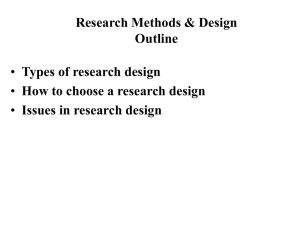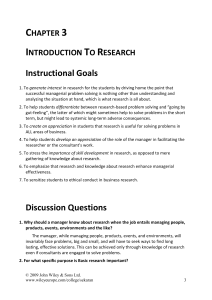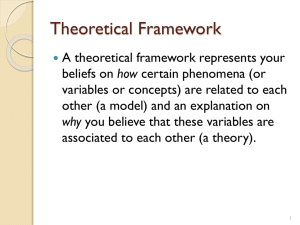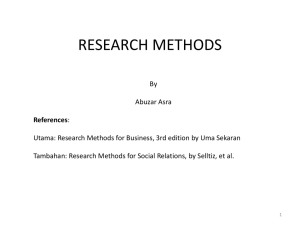Research +
advertisement
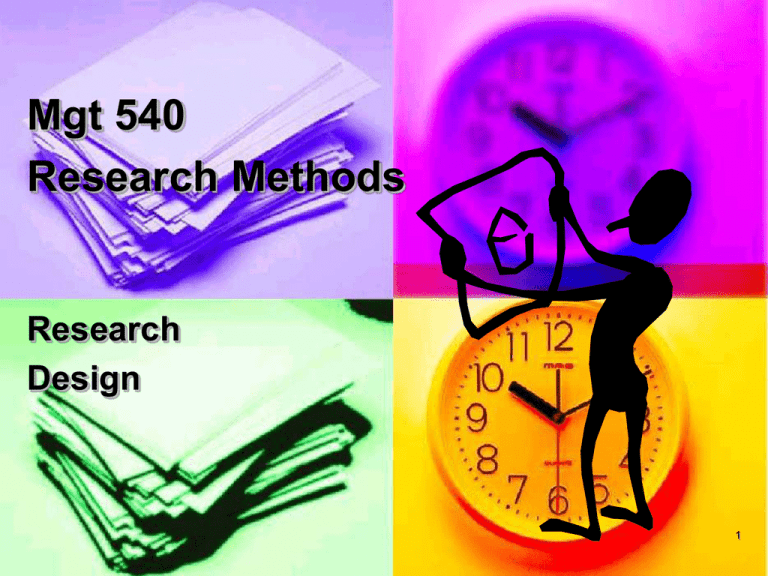
Mgt 540 Research Methods Research Design 1 Research Design FIGURE 6.1 2 Copyright © 2003 John Wiley & Sons, Inc. Sekaran/RESEARCH 4E Research Design Choices are dictated by: Research Question Extent of rigor needed Facility and resources available Function of: Purpose of study Type of study Exploratory, Descriptive, Hypothesis Testing Causal, correlational Setting Field, Field Experiment, Lab 3 Elements of Research Design FIGURE 6.2 4 Copyright © 2003 John Wiley & Sons, Inc. Sekaran/RESEARCH 4E Purpose of Research Exploratory Increase general understanding of context Descriptive Broad Identify variables Identify relationships Hypothesis testing Analytical or Predictive Focused Nature of relationships Nature of (explanation) of variations of the variables 5 Types of Investigation Correlational (associations) “Are smoking and cancer related?” Causal (directional) “Does smoking cause cancer?” Usually requires manipulating the precedent variable Varying degrees of manipulation Controlling the independent variable Usually requires longitudinal study 6 Research Settings Natural Field Studies Field Experiment Contrived Lab Experiment 7 Units of Analysis Directly related to the research question Individual Dyads 2 persons Bi-directional interaction Groups More than 2 persons Multi-directional interactions 8 Time Cross Sectional Point in time Longitudinal Time Series Continual Incremental Cross-Sectional 9 Scenario #1 A manager is intrigued why some people seem to derive joy from work and get energized by it, while others find it troublesome and frustrating. Identify the purpose of the study The type of investigation Field study The time horizon for the study Minimal The study setting Hypothesis testing The extent of researcher interference Correlational One-shot (cross-sectional) The unit of analysis Individual 10 Scenario #2 A foreman things that the low efficiency of the machine tool operators is directly linked to the high level of fumes emitted in the workshop. He would like to prove this to his supervisor through a research study. Would this be a causal or correlational study? Is this exploratory, descriptive, or hypothesis testing (analytical or predictive) study? Minimal What kind of study would this be: Field study, field experiment, or lab experiment? Hypothesis testing – analytical (causality) The extent of researcher interference Causal Field experiment (manipulation required) What will be the unit of analysis? Individual (operators) 11 Exercise 6.2 Many were concerned about the operations of the infamous BCCI, the international banking institution. If the Government had desired to probe into the details, would this investigation have called for: A causal or correlational study? An exploratory, descriptive, or hypothesis testing (analytical or predictive) study? Descriptive – describing operations A field study, field experiment, or lab experiment? Correlational – probe into details, not causes Field study – natural environment Cross-sectional or longitudinal study? 12 Cross-sectional – collected at one point in time 13 Copyright © 2003 John Wiley & Sons, Inc. Sekaran/RESEARCH 4E 14 Copyright © 2003 John Wiley & Sons, Inc. Sekaran/RESEARCH 4E 15 Copyright © 2003 John Wiley & Sons, Inc. Sekaran/RESEARCH 4E 7C 16 Copyright © 2003 John Wiley & Sons, Inc. Sekaran/RESEARCH 4E 7D 17 Copyright © 2003 John Wiley & Sons, Inc. Sekaran/RESEARCH 4E 7E Factors Affecting Internal Validity P. 156 History effects Maturation effects Testing effects Instrumentation effects Selection bias Statistical regression Mortality 18 History Effect 19 Copyright © 2003 John Wiley & Sons, Inc. Sekaran/RESEARCH 4E FIGURE 7.1 Maturation Effects 20 Copyright © 2003 John Wiley & Sons, Inc. Sekaran/RESEARCH 4E FIGURE 7.2 External Validity Generalizability Applicability to other settings Control of variables Selection Interaction with treatment(s) 21 Research Designs Designs are intended to minimize threats to internal and external validity 22 Treatment Effect 23 Copyright © 2003 John Wiley & Sons, Inc. Sekaran/RESEARCH 4E FIGURE 7.3 Treatment Effect 24 Copyright © 2003 John Wiley & Sons, Inc. Sekaran/RESEARCH 4E FIGURE 7.4 Treatment Effect 25 Copyright © 2003 John Wiley & Sons, Inc. Sekaran/RESEARCH 4E FIGURE 7.5 Treatment Effect 26 Copyright © 2003 John Wiley & Sons, Inc. Sekaran/RESEARCH 4E FIGURE 7.6 Completely Randomized Design 27 Copyright © 2003 John Wiley & Sons, Inc. Sekaran/RESEARCH 4E FIGURE 7.8 Design Decision Points 28 Copyright © 2003 John Wiley & Sons, Inc. Sekaran/RESEARCH 4E FIGURE 7.7 Randomized Block Design 29 Copyright © 2003 John Wiley & Sons, Inc. Sekaran/RESEARCH 4E FIGURE 7.9 Latin Square Design 30 Copyright © 2003 John Wiley & Sons, Inc. Sekaran/RESEARCH 4E FIGURE 7.10 3 x 3 Factorial Design 31 Copyright © 2003 John Wiley & Sons, Inc. Sekaran/RESEARCH 4E FIGURE 7.11 Cause-Effect Relationships after Randomization 32 Copyright © 2003 John Wiley & Sons, Inc. Sekaran/RESEARCH 4E TABLE 7.1 Designing for Minimizing Threats to Validity Table 7.2 Based on random selection of members 33
